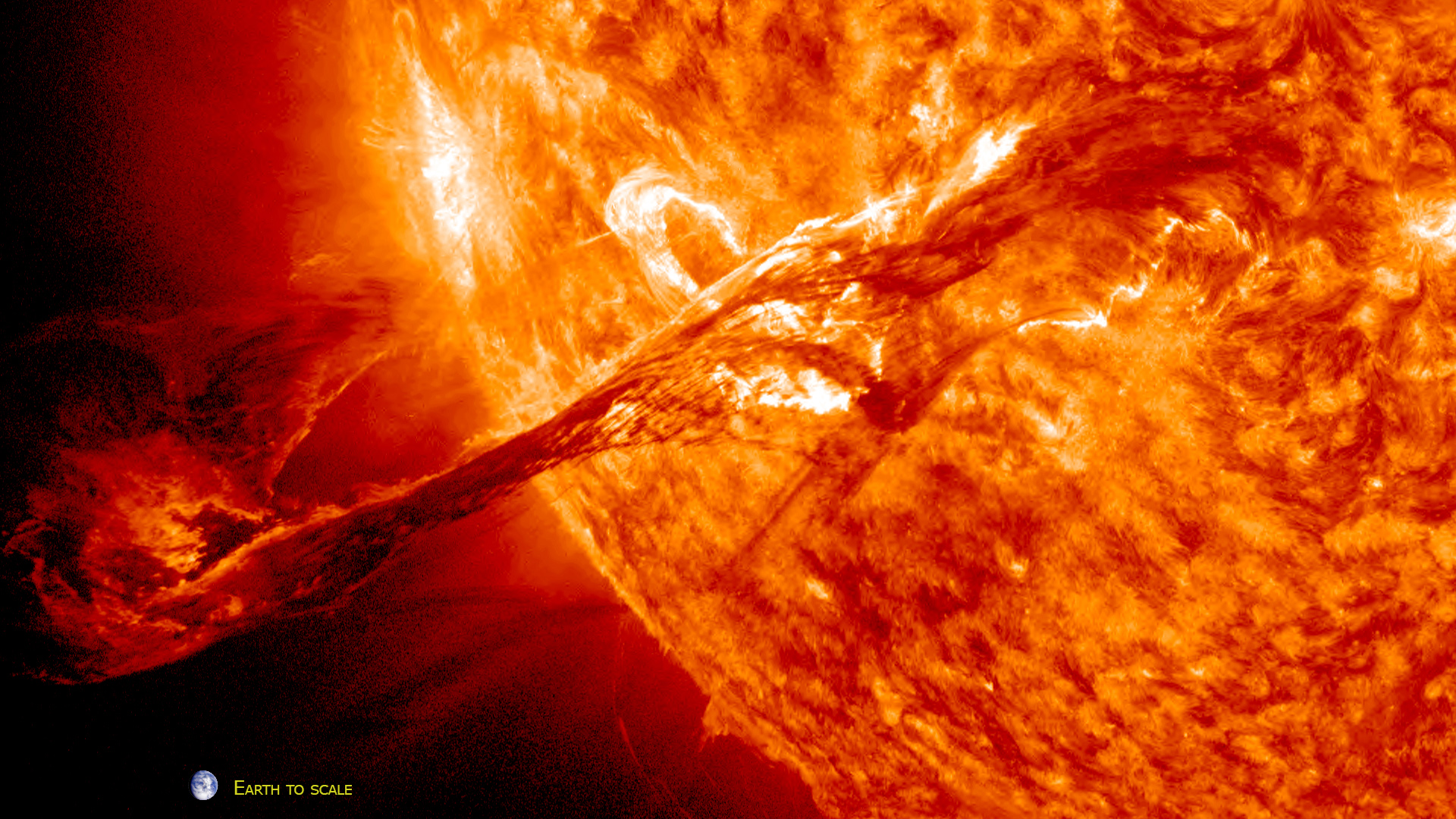What are coronal mass ejections?
These balls of plasma get launched at high-speed from the sun.

A coronal mass ejection (CME) is a vast cloud of electrically charged particles from the sun's upper atmosphere or corona that's heated to enormous temperatures and launched with a huge burst of speed by the energy released in a solar flare. These hot blobs of plasma can have spectacular effects on planets that lie in their path, and while CMEs don't present a direct threat to life on Earth, they can potentially damage the technologies on which human society relies.
"CMEs can cause geomagnetic storms upon their arrival in the near-Earth environment," Stephanie Yardley, a space weather expert at University College London, U.K. told Live Science. "These produce ground-induced currents that degrade power grids, and they can also affect the accuracy of GPS and GNSS satellite navigation systems."
What causes CMEs?
CMEs originate from the same process that creates solar flares — they form when a huge loop of the sun's magnetic field, pushing out through the visible surface or photosphere, becomes pinched together near its base and suddenly reconnects at a lower level. This process liberates a huge amount of excess energy in the form of high-energy electromagnetic radiation, and also heats the gases around the reconnection site, sometimes to temperatures of 36 million degrees Fahrenheit (20 million degrees Celsius) or more. This gives particles around the site, including those in the now-isolated loop of magnetic field above, a massive boost of speed and energy, producing a huge bubble of expanding hot gas that escapes from the sun's gravitational pull and races out across space. CMEs can travel at speeds of hundreds of miles per second — the fastest and most energetic may take less than a day to reach Earth's orbit, but on average they take about 84 hours, according to the National Oceanic and Atmospheric Administration's Space Weather Prediction Center.
Coronal mass ejections 2022
Here's a list of the CMEs launched by the sun in 2022, based on data gathered by software that detects images from the so-called LASCO instrument (a spectrometric coronagraph) onboard the SOHO craft (Solar and Heliospheric Observatory).
Geomagnetic storms
When Earth lies in a CME’s firing line, the results can be dramatic. The material contained in a CME is electrically charged and carries tangled remnants of the severed magnetic loop, so it can strongly distort Earth's own magnetic field, known as the magnetosphere.
Normally, this field deflects the steady stream of particles known as the solar wind as it flows out from the sun. This compresses the magnetosphere on the sun-facing side but creates a long tail (called a magnetotail) that stretches far beyond the moon's orbit on the night side. Most of the solar wind is diverted around the magnetosphere altogether, but charged particles with certain energies can become trapped in doughnut-shaped regions thousands of miles above Earth’s surface known as the Van Allen radiation belts, while others are channeled into the atmosphere above the poles. Here, the charged particles collide with gas particles in Earth’s upper atmosphere, energizing those molecules to create the beautiful glow of the aurorae, such as the northern lights.
A CME's arrival can disrupt this delicate balance. The surge in the number of particles sweeping past Earth results in many more of them being channeled into the atmosphere above the poles, creating intense aurorae that extend to much lower latitudes. Meanwhile, the increase in pressure in the magnetosphere and interactions with the tangled magnetic fields within the CME temporarily warp the magnetosphere, bringing it much closer to Earth.
Get the world’s most fascinating discoveries delivered straight to your inbox.
What's more, the effect is not only magnetic. A physical phenomenon called electromagnetic induction means that a changing magnetic field normally causes electric currents to flow through nearby materials.In the case of a CME hitting our planet, every conductor on Earth, including Earth itself, is exposed.
This means that currents flow through and mess up power grids and can scramble satellite-based navigation systems.
The Carrington Event
These electrical effects were how the very first — and most powerful known — geomagnetic storm was detected in 1859. That year, British astronomers Richard Carrington and Richard Hodgson spotted an outburst in the sun's atmosphere (the first and brightest solar flare ever observed), and shortly afterwards a CME arrived and wreaked magnetic havoc across the world. Shifting magnetism around the wires of the recently-built electric telegraph network created strong electric currents that caused pylons to spark, gave telegraph operators shocks, and even enabled messages to be sent without external power. At the same time, spectacular aurorae stretched down to the tropics, illuminating the night sky brightly enough to read newspapers, Wired reported.
"The Carrington event produced the most powerful geomagnetic storm on record. It was also the fastest CME observed and only took 17.5 hours to reach Earth,” Yardley said. "Theoretically CMEs may have a speed limit of around 3000 km/s [6.7 million mph], which is consistent with the energy available from the regions of strong magnetic fields that produce them."
How do CMEs affect Earth and astronauts?
Fortunately for life on Earth, the magnetosphere and atmosphere combine to form an effective barrier that deflects and blocks CME particles from reaching the surface of our planet, according to NASA. Despite moving at incredibly rapid speeds by everyday standards, CME particles’ energies are too low to penetrate the magnetosphere. Above the poles, where some of the particles are channeled downwards, they collide with and energize the sparse gas atoms and molecules — usually at altitudes between around 50 and 90 miles (80 to 145 kilometers) — to produce aurorae, according to a classic 1946 study in the journal Terrestrial Magnetism and Atmospheric Electricity.
Astronauts in low-Earth orbit (for example on board the International Space Station) remain well inside the magnetosphere and also benefit from its shielding effect — in fact, the passage of a CME offers a surprising benefit as its flood of low-energy material briefly provides an extra layer of protection from high-energy cosmic ray particles emitted by violent events elsewhere in our galaxy and beyond, according to NASA.
For astronauts outside of the magnetosphere, however — for instance on a future mission to Mars — the higher-energy particles within a CME can present a significant risk to health. NASA scientists and engineers are busy investigating various options for providing shielding.
Risks to technology
While CMEs may not present a major direct threat to life, the huge advances in technology since the Carrington event mean that human society is far more vulnerable to CMEs’ indirect effects. In 2003, for instance, a geomagnetic storm triggered by the largest solar flare of the modern era affected electricity supplies in Sweden and South Africa, while aircraft were rerouted to avoid high-altitude flights over the poles. Some 47 satellites experienced failures either due to radiation damage or through static electric charge that accumulated on their surfaces, while astronauts aboard the ISS were forced to retreat into the most heavily shielded parts of the station, according to a Royal Academy of Engineering report on solar weather.
Solar flares can also shorten the lives of satellites in another way — a major flare or the energizing particles from a CME can heat Earth's upper atmosphere and cause it to expand substantially, increasing the drag on satellites in orbits close to Earth and sending them spiraling inwards to re-enter the atmosphere and burn up. In February 2022, SpaceX lost a fleet of more than 40 Starlink mini-satellites in this way after their launch coincided with a solar storm, MIT Technology Review reported.
Can CMEs be predicted?
A 2008 report by the National Academy of Sciences estimated that a severe geomagnetic storm could have an impact of up to $2 trillion in both immediate damage and knock-on effects, with the world taking up to a decade to recover. But even though there's no way of avoiding a major CME that heads toward Earth, precautions can lessen the impact. Satellites can be put into safe mode where they are less likely to suffer lasting harm, and power grids can also be protected.
"For example, the [U.K.] National Grid can reduce the impact to their power systems by turning on as many power lines and high voltage equipment as possible to reduce the burden of excess current running through their system so they do not become overwhelmed," Yardley said.
For these and other reasons, it's vital to track CMEs so that various precautions can be taken before their arrival. "Once CMEs are observed, their propagation is modeled to predict their arrival time at Earth," Yardley said. "Our arrival predictions are currently accurate to within around plus/minus 12 hours. However, it is very difficult to determine their impact (which is measured through the orientation of the magnetic field) until they pass over spacecraft that are very close to Earth, giving us approximately a 1-hour warning of whether they will be geoeffective or not."
Additional resources
Keep current on the state of the sun and Earth's auroras at the National Oceanographic and Atmospheric Administration Space Weather Prediction Center. The spaceweatherlive.com website also tracks the changing relationship between the sun and Earth, while the European Space Agency/NASA Solar and Heliospheric Observatory (SOHO) spacecraft continues to provide real-time updates on the sun after more than 25 years in space.
Originally published on Live Science.

After studying astronomy at University College London and Science Communication at Imperial College, Giles set out on an Exciting Adventure with Illustrated Publishing. He's since written a string of beautiful and successful books on astronomy, science and other cool subjects, and is also a regular contributor to magazines. When he's not doing the day job, you’ll find him fanboying about Doctor Who or lost in some obscure corner of history…




